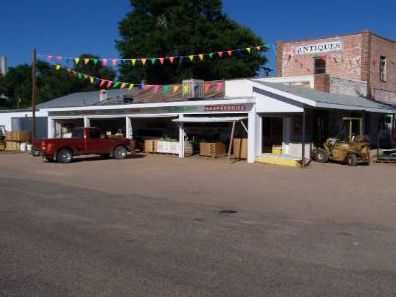
reference-image, l
(article, Deborah Madison)
A week or so ago, my husband and I drove along the eastern edges of New Mexico and Colorado, through the panhandle of Nebraska, to Rapid City, South Dakota, where I spoke at the local-foods summit put on by the Dakota Rural Action Network, a great bunch of very down-to-earth people. Temperatures of 104 and a fly-covered DQ in Clayton, New Mexico, were low points, but the rest was remarkable — hours driving over the most beautiful green, rolling landscape on small roads, watching the wheat harvest being brought in, an impromptu conversation over breakfast with a horseman somewhere in northeastern Colorado, and hours with M.J. Adams, the chef-owner of the Corn Exchange in Rapid City, the only good restaurant between here and South Dakota if you travel on the back roads. Returning on another two-lane, we arrived at Rocky Ford. I was primed to buy one of the famous Rocky Ford melons, and what better place, after all? [%image reference-image float=right width=400 caption="Smith's farm stand, a good place to pick up a Rocky Ford melon."] We turned into Smith’s farm stand, and there were the promised melons. Not only were there Rocky Fords (cantaloupes), but there were also Cavaillons and a tiny, netted melon grown for its small size, just the kind of treasure I like to find. In my talk, I had spoken about how, at farmers’ markets, children are often attracted to small things (a tiny cauliflower) or odd things (three-legged carrots). And here, at the farm stand, stood a small girl happily picking out first this, then that miniature melon, completely ignoring the big beauties to her left and right. We bought tomatoes, squash, peaches, big broad Romano beans, beets, and a host of other good things. For the next few hundred miles, our car filled with the sweet, heady aroma of the melons. [%image melon float=left widtd=300 caption="Rocky Fords."]When we got home, we sliced into the golden skin of the Rocky Ford. The meat was not orange, but green. Sweet, soft, silky, and aromatic, it was everything you could want in a melon. What made it a Rocky Ford? According to melon expert Amy Goldman, author of Melons for the Passionate Gardener, the Rocky Ford was developed from a Burpee’s melon called Netted Gem, and renamed Rocky Ford after that spot on the eastern Colorado plains where it’s grown. There are both orange and green-meat selections of “Perfecto,” as the original selection was also called. But whatever the name, a ripe, firm, sweet melon is one of summer’s joys, along with peaches and broad beans. And what made it even better was the 15-year-old girl at the stand who actually knew how to pick a good melon and could talk smartly about everything else her family grew. Road food may be dismal, but this farm stand gave me hope. p(bio). Deborah Madison is the author of numerous award-winning cookbooks, including Local Flavors. She lives in New Mexico.

reference-image, l

melon, l